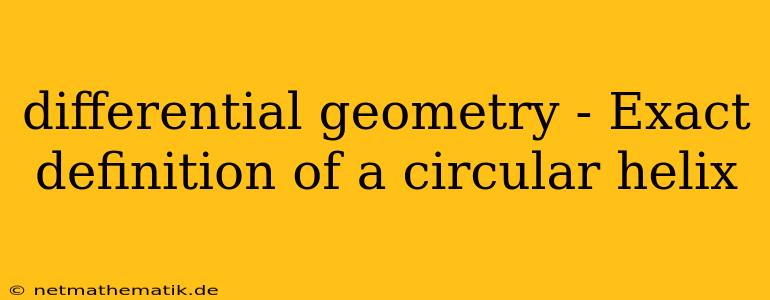In the realm of differential geometry, the concept of a circular helix occupies a prominent position, representing a fundamental curve with both theoretical and practical significance. A helix, in general, is a three-dimensional curve that winds around a central axis, maintaining a constant distance from it. This constant distance is referred to as the radius of the helix, and the path traced by the helix is characterized by its curvature and torsion. The circular helix, specifically, possesses a constant curvature and a constant torsion, resulting in a uniform and elegant spiral shape. This article delves into the exact definition of a circular helix, exploring its key properties and providing a comprehensive understanding of its mathematical representation.
The Exact Definition of a Circular Helix
A circular helix is a three-dimensional curve that can be defined in various ways, each highlighting specific aspects of its geometric nature. One common and intuitive approach is to define it as the path traced by a point that moves at a constant speed along a cylinder, while simultaneously rotating around the cylinder's axis at a constant rate.
Parameterization of a Circular Helix
A precise mathematical representation of a circular helix is achieved through parametric equations. Let r be the position vector of a point on the helix, and let t be a parameter representing the arc length along the curve. Then, the parametric equations for a circular helix are given by:
r(t) = (a cos(t), a sin(t), bt)
where:
- a is the radius of the cylinder,
- b is a constant that determines the pitch of the helix (the vertical distance between successive turns), and
- t is the parameter, typically ranging from 0 to 2π for one complete turn of the helix.
Visualizing the Parameterization
The parametric equations clearly illustrate the defining characteristics of a circular helix:
- Circular Motion: The terms a cos(t) and a sin(t) represent the projection of the point onto the x-y plane, resulting in a circular motion with radius a.
- Linear Motion: The term bt represents the vertical displacement of the point along the z-axis. As t increases, the point moves upward at a constant rate, creating the helix's characteristic spiral.
Properties of a Circular Helix
The circular helix exhibits several distinctive properties that set it apart from other curves:
- Constant Curvature: The curvature of a circular helix remains constant throughout its length. This means that the rate at which the helix bends is uniform. The curvature is given by κ = a/(a² + b²).
- Constant Torsion: Similarly, the torsion of a circular helix is also constant. Torsion measures the rate at which the helix twists, and its value for a circular helix is τ = b/(a² + b²).
- Frenet Frame: At every point on a circular helix, a special frame of reference known as the Frenet frame can be constructed. This frame consists of three orthogonal unit vectors: the tangent vector T, the normal vector N, and the binormal vector B. The Frenet frame is useful for analyzing the local geometry of the helix.
Understanding the Properties
The constant curvature and torsion of a circular helix contribute to its visually pleasing and mathematically elegant form. These properties make the circular helix a ubiquitous curve in various applications, including:
- Screw Threads: The threads of a screw are often modeled as circular helices, ensuring uniform engagement and consistent mechanical action.
- DNA Structure: The double helix structure of DNA is a classic example of a circular helix in nature, with the two strands of nucleotides intertwined in a helical configuration.
- Spring Design: Springs are often designed with helical shapes, taking advantage of the elastic properties of the material and the helix's resistance to compression and tension.
Applications of Circular Helix
Beyond its theoretical significance, the circular helix finds numerous practical applications in various fields:
- Engineering: In mechanical engineering, the circular helix is essential in the design of gears, springs, and screw threads, ensuring optimal performance and functionality.
- Architecture: Circular helices are incorporated in architectural designs, providing unique and visually appealing structural elements.
- Biomedical Engineering: The circular helix plays a crucial role in understanding the structure and function of DNA, proteins, and other biological molecules.
- Computer Graphics: Circular helices are used extensively in computer graphics and animation, creating realistic and visually captivating models of objects.
Conclusion
In conclusion, the circular helix stands as a fundamental and versatile curve in differential geometry, possessing a wealth of theoretical and practical significance. Its exact definition through parametric equations, along with its constant curvature and torsion, contribute to its unique and elegant form. The circular helix's applications extend across numerous fields, highlighting its importance in engineering, architecture, biomedical sciences, and computer graphics. Its mathematical beauty and practical utility make it a subject of continued fascination and exploration in the realm of mathematics and beyond.
